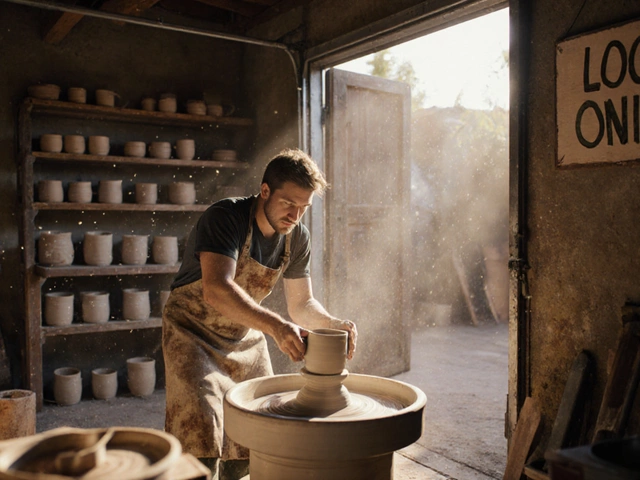Imagine taking an idea from a mere glint in your mind to a product held in your hands. That’s the heart of small scale production. Unlike large-scale operations, which often involve sprawling factories and assembly lines, small scale manufacturing focuses on limited quantities, offering unique challenges and opportunities for innovation.
From ideation to execution, the journey of small scale production involves a series of well-coordinated steps. It’s a dance between creativity and practicality, requiring thoughtful planning and agile problem-solving. For those eager to understand this captivating process, we’ll tiptoe through these stages, examining everything from managing resources to ensuring quality, all to better equip the adventurous spirits embarking on this production journey.
- From Concept to Creation
- Supply Chain Management
- Quality Control in Small Batches
- Scaling Up: When Small Becomes Bigger
From Concept to Creation
Embarking on the path from concept to creation in small scale manufacturing is a unique adventure that begins with a seed of an idea. This initial stage is where dreams meet tangibility. Here, imagination plays a crucial role, as does a pragmatic approach to logistics. It all starts with identifying a market need or a gap that your idea fills. Detailed market research helps validate the need, ensuring there’s indeed an audience ready to embrace your product. This step involves analyzing competitors, understanding consumer behavior, and identifying potential barriers. A thorough understanding of the market landscape is essential, as noted by the Harvard Business Review, "Innovations fail when market assumptions don’t hold up."
Once the viability of the idea is established, it transitions into the design phase. During this phase, various prototypes are created to refine the product’s features and functionality. This iterative process is invaluable, as it allows for continuous improvement while keeping resources in check, especially vital in small scale manufacturing where resources might be limited. Leveraging tools like CAD software can streamline this phase, enabling precise modeling and adjustments. Alongside design, securing intellectual property rights becomes significant if the product is uniquely innovative. Protecting ideas through patents or trademarks ensures a competitive edge and prevents unauthorized replication.
Following design, sourcing materials marks the next critical step. Opting for quality materials is imperative to ensure durability and customer satisfaction. Herein lies the art of balancing cost with quality, a challenge that every small-scale producer faces. Establishing a reliable supply chain management system, where raw materials are sourced consistently and economically, plays a pivotal role. Consider collaborating with local suppliers as they often offer competitive pricing and reduced transportation costs. This not only promotes sustainability but also aligns with the growing consumer preference for locally sourced goods.
Once materials and design are ready, production begins. In a small scale manufacturing setup, leveraging skilled labor is key. Often, smaller quantities mean products can be hand-crafted or produced using semi-automated processes. This allows for a high degree of quality control and customization, catering directly to niche market demands. It's during this phase that the importance of a streamlined production process becomes apparent. Adopting lean manufacturing principles can significantly aid in minimizing waste, optimizing productivity, and ensuring a smooth workflow.
Finally, as the product morphs from thought to reality, packaging and distribution strategies must be devised. Packaging not only preserves the product but also enhances the brand value and appeal. It serves as the first physical touchpoint with the customer and, therefore, must convey the essence of what your brand stands for. Careful consideration of packaging design, materials, and eco-friendliness pays dividends in brand loyalty. From there, distribution channels are chosen based on target market preferences, balancing online and offline approaches. The right logistics strategy ensures timely delivery without inflating costs, crucial for maintaining customer satisfaction in competitive markets.
"A successful product journey from concept to creation isn't just about the idea but execution at each stage." – An insightful reminder from industry experts.

Supply Chain Management
Small scale manufacturing relies heavily on a well-organized supply chain to ensure that production runs smoothly and efficiently. In this context, the supply chain encapsulates every part of the process from sourcing raw materials to delivering the final product to customers. It's essential for those involved in small scale manufacturing to develop strong relationships with suppliers who can deliver quality materials in appropriate quantities. Managing these relationships can be a complex task, as finding suppliers who cater to smaller batches without sacrificing quality or increasing costs is a unique challenge.
Cost management is another critical aspect. Unlike large manufacturers, small scale producers may not benefit from economies of scale, making it more important to negotiate favorable terms with suppliers. This might involve collaborating with other small businesses to place larger orders or exploring local suppliers to reduce shipping costs and time. "A successful supply chain doesn’t just move materials; it fuels the entire production by aligning suppliers’ capabilities with the company's mission," once noted by Keith Oliver, a renowned logistics consultant.
Moreover, inventory management plays a pivotal role in ensuring a balanced flow of materials through the production process. Small scale manufacturers often operate with limited storage space, making it crucial to implement just-in-time inventory systems to minimize holding costs while still maintaining enough stock to meet production demands. A common technique is to employ buffer stocks strategically, which can protect against sudden supply disruptions yet still require diligent monitoring to avoid surplus waste.
Logistics efficiency is another key factor in supply chain management. Efficient logistics can make a significant difference in the competitiveness of small scale manufacturers by shortening delivery times and improving customer satisfaction. Utilizing digital tools to track shipments and communicate with suppliers in real-time can increase visibility across the supply chain, allowing businesses to respond swiftly to any delays or issues.
Risk management is equally vital. The COVID-19 pandemic highlighted vulnerabilities in global supply chains, encouraging many to reassess and strengthen their strategies. Developing flexible, adaptable supplier networks can mitigate risks associated with unforeseen disruptions. At times, diversifying supply sources can serve as a hedge against these risks, albeit requiring additional coordination and potentially higher administration costs.
| Aspect | Importance |
|---|---|
| Supplier Relationship | Critical for quality and cost management |
| Cost Management | Essential due to lack of economies of scale |
| Inventory Management | Keeps production on schedule and prevents waste |
| Logistics | Enhances speed and customer satisfaction |
The dynamic nature of supply chain management in small scale manufacturing requires a blend of strategic planning, technology adoption, and agility. Success in this field often hinges on an entrepreneur's ability to weave creativity with practical solutions, leading to a robust operation capable of thriving even amidst market fluctuations.

Quality Control in Small Batches
Quality control in small scale manufacturing is an essential facet that ensures each product meets the intended standards and customer expectations. Unlike large production lines, where a single defect might get lost in the shuffle, small batch production places a spotlight on each unit. Every item crafted holds a significant part of the reputation of the manufacturer. Due to limited quantities, the stakes are higher; a single mistake can dramatically impact the entire batch’s perceived quality.
At the heart of effective quality control is the ability to maintain consistency over time. This is where the manufacturer’s keen eye and dedication to detail play a crucial role. One effective method is to craft a detailed checklist that encompasses all necessary quality criteria for each stage of production. This ranges from selecting raw materials to the finishing touches on the final product. Regular audits using these checklists can help businesses identify weak points in their processes and rectifying them swiftly.
Handling Limited Resources
Small scale manufacturers often operate with limited resources and budgets, making it vital to be crafty about quality assurance practices. Investing in advanced quality testing equipment might not always be feasible, so leveraging alternative strategies becomes important. For instance, sampling methods can be employed where a percentage of the output is thoroughly tested to deduce the quality status of the entire batch. It's not just about technological tools but also training the workforce to recognize quality issues and empowering them to take action when needed.
"In small batch production, quality isn’t just a goal; it’s a commandment." — Philip Crosby, a noted quality management theorist
Leveraging customer feedback is another pivotal element of quality control. For small business production, maintaining close relationships with customers allows for direct and useful insights into their satisfaction and expectations. Implementing these insights into future production cycles can drastically improve the product's quality over time, creating a positive feedback loop.
Smaller Scale, Greater Flexibility
One of the distinct advantages of small scale manufacturing lies in its inherent flexibility. Manufacturers can swiftly pivot and tweak their processes without causing major disruptions, which is a luxury larger-scale operations often lack. This adaptability can be leveraged to continuously refine production techniques and integrate quality enhancements more frequently. By implementing minor adjustments along the way, companies can enhance product quality without waiting for prolonged cycles.
| Batch Size | Quality Assurance Method |
|---|---|
| 1-50 units | Manual Inspection |
| 50-200 units | Statistical Sampling |
| 200+ units | Automated Testing |
Ultimately, while the size of production might be limited, the ambition for quality shouldn’t be. Viewing each batch as a chance to foster excellence rather than a challenge will propel small businesses to newfound heights, ensuring that exceptional quality becomes synonymous with their brand. The journey of quality control in small batches becomes an experience of learning and perfecting—a testament to the craftsmanship and commitment that goes into every product.

Scaling Up: When Small Becomes Bigger
Scaling up a small scale production operation to meet increasing demand is both a thrilling and daunting challenge. It's like nurturing a sapling into a sturdy tree. You’ve proven the viability of your product on a limited scale, and now it's time to grapple with the complexities of larger operations. This phase demands a shift in mindset from tight-knit production to embracing broader horizons, which can bring substantial rewards. Small scale manufacturing often begins with handcrafted methods or limited batch runs, but scaling up requires adopting more efficient systems. Investing in better equipment or customized machinery can significantly boost productivity. However, scaling isn't just about buying bigger machines. It’s essential to re-evaluate and optimize every step of the production process.
One crucial aspect of scaling is production tips for enhancing supply chain efficiency. You may find yourself forming new partnerships with suppliers who can handle larger volumes or offer better prices due to bulk orders. Each of these logistic decisions should balance cost-effectiveness with maintaining product quality. This delicate harmony can make or break your transition from small scale to a more ambitious endeavor. According to a manufacturing industry report, about 65% of small businesses face challenges when expanding production, highlighting the need for thorough planning and risk management.
The Role of Technology
Technology plays an indelible role in scaling operations. It's not just about automating tasks but also utilizing analytics to pinpoint inefficiencies and predict future trends. Implementing ERP (Enterprise Resource Planning) systems can streamline operations, saving time and reducing human error. This tech integration enables businesses to maintain their core values while enhancing output quality and consistency across larger volumes.Quality Assurance
In the journey of scaling up, it’s easy to overlook quality control. A surge in production volume can sometimes lead to inconsistencies creeping into the finished product. It's imperative to bolster quality control in small batches practices even as operations scale. Setting up robust checks and protocols ensures that each item meets the standards that your initial customers appreciated. This consistency not only keeps existing customers happy but also helps to build brand loyalty among a broader audience.The transition from small to bigger production can be remarkably rewarding, but it requires courage and diligent preparation. Maintaining the spirit and ethos of your original production while embracing the necessary changes will help in successfully navigating this exhilarating phase.





